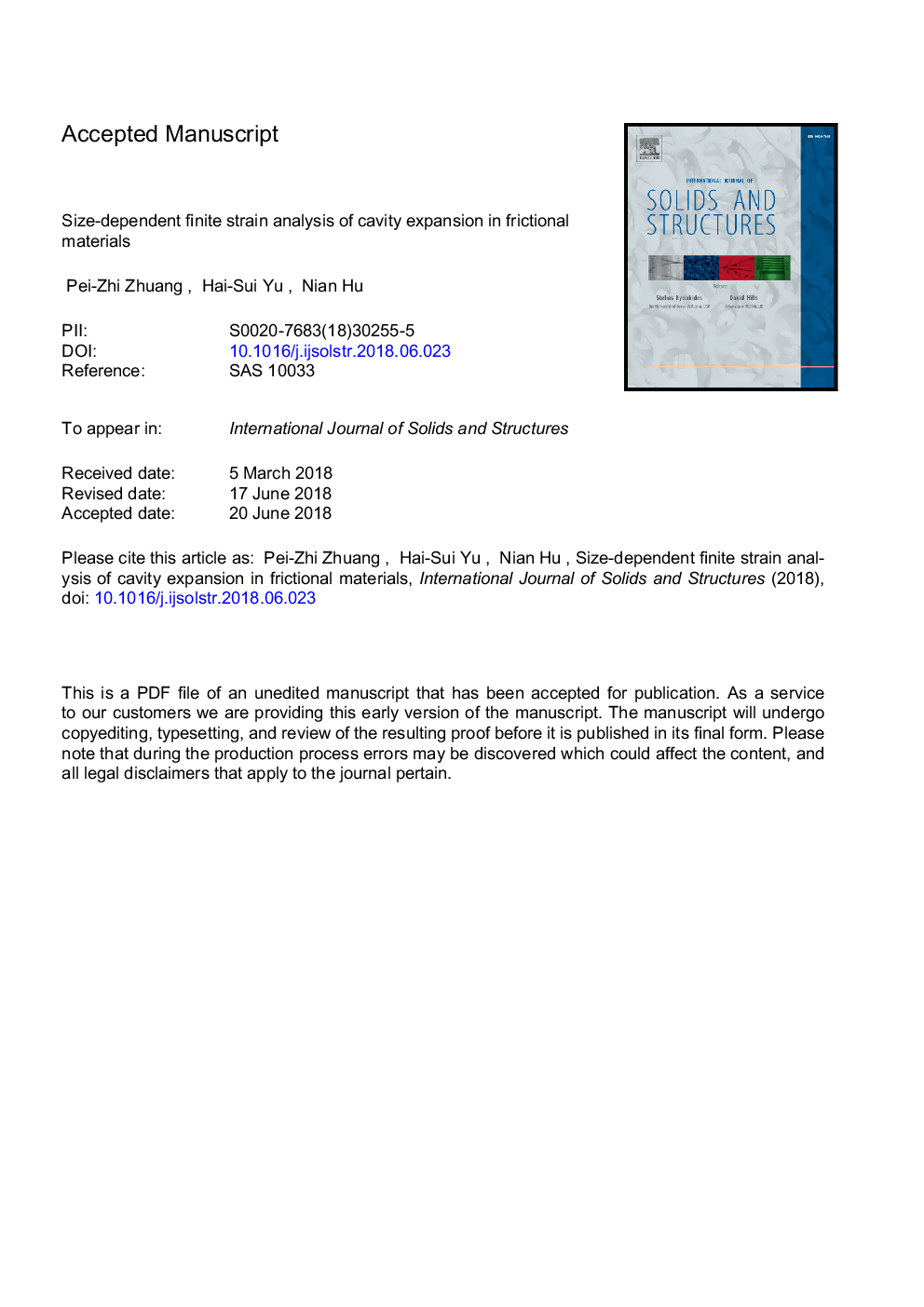| کد مقاله | کد نشریه | سال انتشار | مقاله انگلیسی | نسخه تمام متن |
|---|---|---|---|---|
| 8947124 | 1645547 | 2018 | 41 صفحه PDF | دانلود رایگان |
عنوان انگلیسی مقاله ISI
Size-dependent finite strain analysis of cavity expansion in frictional materials
ترجمه فارسی عنوان
تجزیه و تحلیل کرنش محدود وابسته به اندازه حفره در مواد اصطکاکی
دانلود مقاله + سفارش ترجمه
دانلود مقاله ISI انگلیسی
رایگان برای ایرانیان
کلمات کلیدی
گسترش حفره، انعطاف پذیری شیب اثر اندازه، کشش محدود، تجزیه و تحلیل نیمه استاتیک،
ترجمه چکیده
این مقاله راه حل های یکپارچه برای تجزیه و تحلیل گسترش کششی الاستیک از یک حفره استوانه ای یا کروی را در یک محیط بی نهایت ارائه می دهد، با اتخاذ یک نظریه جریان پلاستیکی شیب فشار. تجزیه و تحلیل گسترش حفره قبلی با استفاده از اثرات شیب فشار بیشتر به توضیح پدیده محلی سازی فشار و / یا اثرات اندازه در طول گسترش بی نهایت متمرکز شده است. با این حال، این مقاله با توجه به رفتار وابسته به اندازه یک حفره در طول تقسیمات شبه استاتیک محدود، مربوط می شود. برای محاسبه نفوذ غیر محلی از ریزساختارهای پایه به رفتار ماکروسکوپی مواد گرانول، معیار عملکرد موری کولبون معمولی با استفاده از یک گرادینت دوم مرتبه اصلاح می شود. بنابراین، مسئله گسترش حفره شبه استاتیک به یک سیستم معادلات دیفرانسیلی عادی مرتبه دوم تبدیل می شود. در تجزیه و تحلیل گسترش حفره پیوسته، معادلات حاکم در نتیجه با تکرارهای ساده با شرایط مرزی کوشی حل می شوند. علاوه بر این، یک روش ساده بدون تکرار برای محاسبه فشار محدود وابسته به اندازه حفره گسترش به یک شعاع نهایی ارائه شده است. با نادیده گرفتن افزایش فشار کششی در منطقه پلاستیکی، راه حل های وابسته به اندازه تحلیلی نیز مشتق می شوند. نشان داده شده است که اثر شیب باروری عمدتا در مجاورت حفره داخلی متمرکز می شود. اثرات اندازه گیری ظاهری مرتبط با اندازه ذرات شن و شعاع حفره در ناحیه تغییر شکل یافته توسط راه حل های تازه توسعه یافته ارائه شده در این مقاله گرفته شده است. اثر گرادیان کرنش هنگامی که طول ماده مادی در مقایسه با اندازه حفره لحظه ای ناچیز است، از بین می رود، و پس از آن می توان دقیقا راه حل های کامل و پلاستیکی الاستیک را بازیابی کرد. راه حل های حاضر می توانند یک روش نظری برای مدل سازی اثر اندازه ارائه دهند که اغلب در مشکلات متقابل ساختار شن و ماسه کوچک دیده می شود.
موضوعات مرتبط
مهندسی و علوم پایه
سایر رشته های مهندسی
مهندسی عمران و سازه
چکیده انگلیسی
This paper presents unified solutions for elastic-plastic expansion analysis of a cylindrical or spherical cavity in an infinite medium, adopting a flow theory of strain gradient plasticity. Previous cavity expansion analyses incorporating strain gradient effects have mostly focused on explaining the strain localization phenomenon and/or size effects during infinitesimal expansions. This paper is however concerned with the size-dependent behaviour of a cavity during finite quasi-static expansions. To account for the non-local influence of underlying microstructures to the macroscopic behaviour of granular materials, the conventional Mohr-Coulomb yield criterion is modified by including a second-order strain gradient. Thus the quasi-static cavity expansion problem is converted into a second-order ordinary differential equation system. In the continuous cavity expansion analysis, the resulting governing equations are solved numerically with Cauchy boundary conditions by simple iterations. Furthermore, a simplified method without iterations is proposed for calculating the size-dependent limit pressure of a cavity expanding to a given final radius. By neglecting the elastic strain increments in the plastic zone, approximate analytical size-dependent solutions are also derived. It is shown that the strain gradient effect mainly concentrates in a close vicinity of the inner cavity. Evident size-strengthening effects associated with the sand particle size and the cavity radius in the localized deformation zone is captured by the newly developed solutions presented in this paper. The strain gradient effect will vanish when the intrinsic material length is negligible compared to the instantaneous cavity size, and then the conventional elastic perfectly-plastic solutions can be recovered exactly. The present solutions can provide a theoretical method for modeling the size effect that is often observed in small-sized sand-structure interaction problems.
ناشر
Database: Elsevier - ScienceDirect (ساینس دایرکت)
Journal: International Journal of Solids and Structures - Volume 150, 1 October 2018, Pages 282-294
Journal: International Journal of Solids and Structures - Volume 150, 1 October 2018, Pages 282-294
نویسندگان
Zhuang Pei-Zhi, Yu Hai-Sui, Hu Nian,
